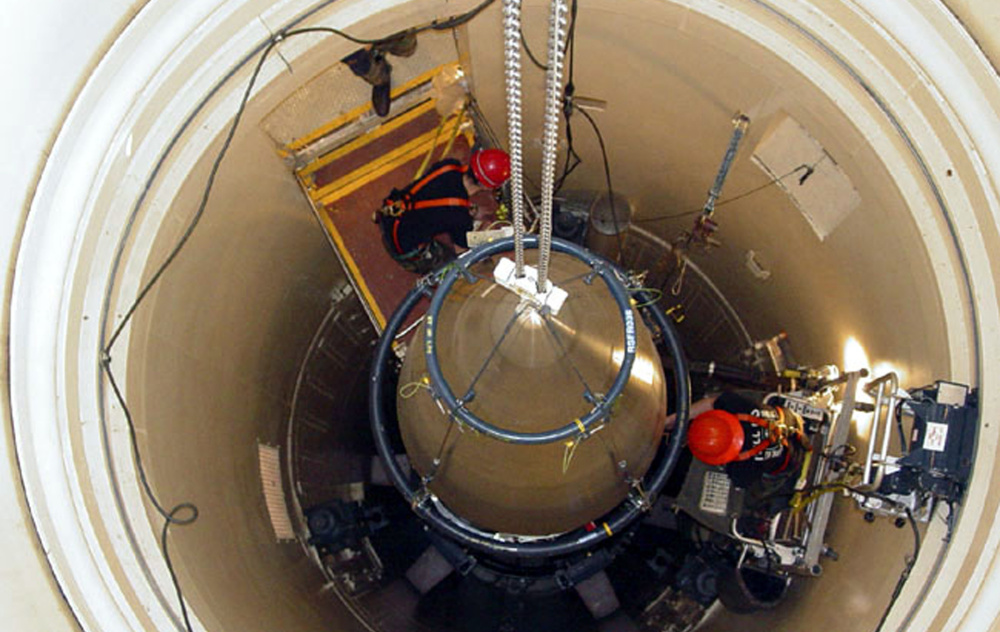WINDHAM — William J. Perry, a former U.S. secretary of defense, recently published a book titled “My Journey at the Nuclear Brink.” Perry was also instrumental in producing a 10-week online class through Stanford University called “Living at the Nuclear Brink.” This class takes the student from the development of the first nuclear weapon through today’s world stockpile of 15,375 nuclear weapons. The United States and Russia account for 93 percent of them.
With relations between the U.S. and Russia more dangerous than during the Cold War, and Donald Trump famously declaring that more countries should acquire nuclear weapons, it is past time to halt the insanity of a world awash with nuclear weapons.
Instead, the 2017 Defense Department budget calls for modernization of every aspect of the U.S. nuclear arsenal, from weapons laboratories to warheads to planes, missiles and submarines. The price tag totals at least $1 trillion over three decades. Other nuclear weapons states are following our lead and making plans to modernize their arsenals as well.
The term “modernization” is a misnomer. In fact, the requested funds will be an initial investment in a new nuclear arms race. Independent Maine Sen. Angus King stated in a recent letter to me that he will closely review the budget request for modernization. Problematically, he ends with this closing statement: “In other words, a credible nuclear capability (and modernization is necessary to maintain credibility) is the best insurance we have that nuclear weapons will never be used.”
Do the military budget planners even consider the fact that nuclear weapons have the potential to end all life on earth? In the last segment of the online nuclear weapons course, we hear Joseph Cirincione, president of the Ploughshares Fund, say, “The two existential threats to humanity are climate change and nuclear weapons.”
Perry, the former defense secretary, has lived his life at the “nuclear brink.” His goal, both in his book and in the online class, is to make the average citizen aware that we are all living there.
Since 1950, there have been 32 nuclear weapon accidents, known as “broken arrows.” A broken arrow is defined as “an unexpected event involving nuclear weapons that results in the accidental launching, firing, detonating, theft or loss of the weapon.” Rudolph Herzog outlines them in his book “A Short History of Nuclear Folly.” It is not a matter of if, it is a matter of when such an incident could occur, potentially resulting in the deaths of thousands or even millions of people.
Did we not learn from Dwight Eisenhower? In his presidential farewell address, he wrote, “In the councils of government, we must guard against the acquisition of unwarranted influence, whether sought or unsought, by the military-industrial complex. The potential for the disastrous rise of misplaced power exists and will persist.”
Have we allowed just such a “misplaced power” to exist? Have we been enthralled with our games of sport, just as the citizens of ancient Rome were enthralled with the “games” in the Colosseum? We cannot continue to stand by and allow our Congress to pass a budget for $1 trillion for the nuclear weapons industry while ignoring our signature on Article VI of the Nuclear Nonproliferation Treaty. We are bound in the treaty to ” take effective measures relating to cessation of the nuclear arms race at an early date and to nuclear disarmament, and … complete disarmament under strict and effective international control.”
I was fortunate to be at The Hague in 1996 when the International Court of Justice issued their opinion on the Legality of the Threat or Use of Nuclear Weapons. The court indicated that “there exists an obligation to pursue in good faith and bring to a conclusion negotiations leading to nuclear disarmament in all its aspects under strict and effective international control.”
The world has already proven it is possible. We have come together to enact treaties to ban landmines, cluster munitions and chemical and biological weapons. Although a United Nations General Assembly resolution to establish a global nuclear weapons ban failed in late 2016, it did garner a positive vote from 123 nations. It will appear again before the General Assembly in this new year.
For a safer world, we must cancel nuclear modernization, challenge other countries to do the same and invest in more life-affirming priorities. Yes, we can invest in diplomacy and international cooperation toward verifiable global nuclear disarmament.
Send questions/comments to the editors.



Success. Please wait for the page to reload. If the page does not reload within 5 seconds, please refresh the page.
Enter your email and password to access comments.
Hi, to comment on stories you must . This profile is in addition to your subscription and website login.
Already have a commenting profile? .
Invalid username/password.
Please check your email to confirm and complete your registration.
Only subscribers are eligible to post comments. Please subscribe or login first for digital access. Here’s why.
Use the form below to reset your password. When you've submitted your account email, we will send an email with a reset code.